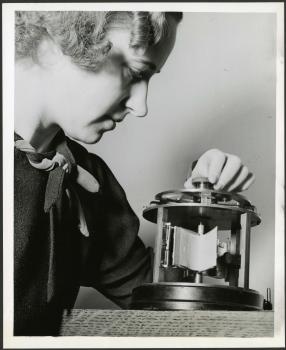Born in San Jose, Illinois, in 1900, Ruby K. Worner (b. 1900) earned three degrees at the University of Chicago: B.S., 1921; M.S., 1922; Ph.D. in chemistry, 1925. She taught briefly at a small school in Oklahoma and in 1927, moved to Washington, D.C., where she worked first as a chemist in the Bureau of Home Economics at the U.S. Department of Agriculture (USDA) and then, for the next eleven years, in the textile division of the National Bureau of Standards. In 1940, she returned to USDA and continued her research on textiles.
 In this photograph from the Science Service engineering files, Worner is shown demonstrating a machine that measured the resistance of different materials to creasing, that is, to the amount of “spring” in the material.
In this photograph from the Science Service engineering files, Worner is shown demonstrating a machine that measured the resistance of different materials to creasing, that is, to the amount of “spring” in the material.
Worner’s experience in the federal government afforded her an opportunity to observe and analyze both the opportunities and challenges for female chemists. In September 1939, she spoke at a Symposium on Training and Opportunities for Women in Chemistry, sponsored by the American Chemical Society’s Division of Chemical Education, and her remarks offered both practical advice and an honest appraisal of what women faced.
In most government science agencies, Worner explained, the men far outnumbered the women. The exception was the USDA’s Bureau of Home Economics, which was then headed by the chemist Dr. Louise Stanley and staffed almost entirely by women.
“Assuming that a woman obtains a position in the Government,” she then asked, “what are her chances for advancement?” Her answer was blunt: “women are rather less likely to advance in the service than are men, assuming equal ability and application.” In part, the salary and other opportunities are biased toward men because men were assumed to be supporting a family. Moreover, “there are still men who object to working on an equal basis or under a women.”
Not all minds were so closed, however, for Worner quoted one male scientist as saying that “the greatest need among women was organization; that, at present, they do not properly appreciate or evaluate their capabilities and consequently do not receive the recognition they deserve.”
So, here’s a salute to Ruby K. Worner, whose keen and honest observations deserve remembering today.
Related Resources
Ruby K. Worner Photo Album, 1925-1930, Collection No. P11D.C., Community Archives, DC Public Library.
Dr. Ruby Worner Scholarship, for student studying Agriculture, Mathematics, Chemistry or Physics, Illinois Central College.
Limitations of the Indirect Untwist-Twist and Direct-Counting Methods for Determining Twist in Carded Cotton Single Yarns by Ruby K. Worner, Textile Research Journal, 1956.
Effect of Purification Treatments on Cotton and Rayon by Ruby K. Worner and Ralph T. Mease, National Bureau of Standards, 1938.
Produced by the Smithsonian Institution Archives. For copyright questions, please see the Terms of Use.

Leave a Comment